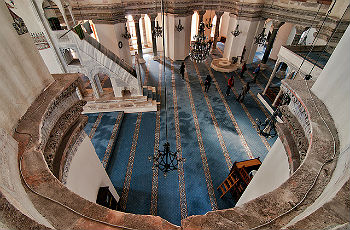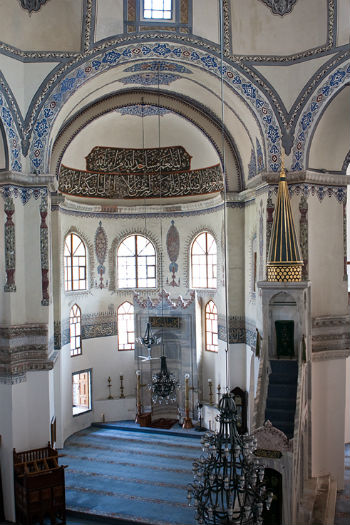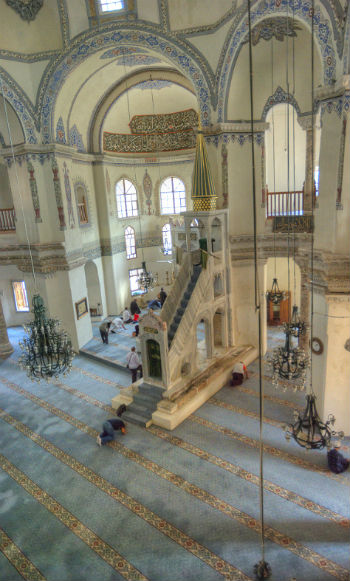Begun in 527 by Emperor Justinian, the Church of Saints Sergius and Bacchus in Istanbul was an early experiment in Byzantine architecture, with a large central dome supported by an octagonal base. The church is now a mosque called Küçük Ayasofya Camii (Little Hagia Sophia Mosque), named for its resemblance to the much larger Hagia Sophia built a few years later.
History
Saints Sergius and Bacchus are Christian Roman soldiers who were martyred in Syria in 303 AD. They became the patron saints of soldiers and their cult was very popular in Syria and beyond.
The Byzantine Emperor Justinian (r. 527-65) was among the saints’ devotees. According to legend, when Justinian was a young man he was condemned to death for plotting against Emperor Anastasius. But Sergius and Bacchus appeared to the emperor in a dream, convincing him to release Justinian.
Justinian began construction on a church dedicated to Sts Sergius and Bacchus immediately after becoming emperor himself in 527 AD; it was completed by 536 AD. The architect was Anthemius of Tralles, a mathematician and the author of a book on burning mirrors, the Paradoxographia. The chosen site was just inside the sea walls west of the Hormisdas Palace (where Justinian lived before ascending the throne), next to the Hippodrome.
The church was connected to a three-aisled basilica dedicated to St. Peter and St. Paul, which Justinian had begun to build in 519. None of it survives today. The Church of Sts. Sergius and Bacchus was built on an octagonal floor plan with a central dome, which inspired the design of the great Hagia Sophia, begun just a few years later in 532. The earlier church was therefore dubbed the Little Ayasofya.
The church was converted into a mosque in the 16th century under Sultan Beyazit II and remains an active mosque today.
What to See
Church of the Saints Sergius and Bacchus is located on the south side of Istanbul next to the Hippodrome; a railway line (near Sirkeci Station) runs between the south wall of the church and sea wall.
The Church of the Saints Sergius and Bacchus interior is decorated and furnished as a mosque, with Arabic calligraphy and designs in blue painted on white walls. Originally, the walls and vault would have been completely covered in golden mosaics, like those that survive from this period in Ravenna, and probably frescoes as well.
The architecture of the building, however, survives fully intact from the Byzantine era. So too does the Greek dedicatory inscription around the central nave:
A fine view of the interior can be had from the gallery stairs are to the right of the entrance.











This little place is so quite and peaceful, there was a school attached to the building and a small graveyard on the other side.
It might not be a must-see but you better take a look and combine it with nearby sites.
It was very nice i took photos insude and the instruments was wonderful i really like very much.
I had no expectations, and I found it incredible. The history, art works, different levels it made it a fascinating few hours.
This was one of the more beautiful mosques I visited in Istanbul. Simple and light, but still magnificent inside. Very authentic area and always interesting to see the church/mosque transitions (like Hagia Sophia and Chora). It is a quick walk from the Hippodrome (maybe 10 minutes or so) and worth checking out.
I've actually done this cruise twice! its the best way to start your vacation in Istanbul… the guided tours give a nice and detailed history of the surrounding sites… there is a much cheaper way to view this by taking a regular ferry.
Restored very simply. An exquisite church. Make sure you go up to the gallery to get a full appreciation for the space and light.
Amazing site and structure it was the biggest Basilica for over Milenium I stood in Awe words and pictures cannot explain its is living History over 1500 years old.
Once you have visited a lot of mosuqes in Istanbul you normally start to wonder how the mosque will look if viewed from the gallery but alas, no way up for the tourist. This small hidden gem is wroth the while going up and down (it is close to the water but only 10 min walk from the blue mosque).
This little church is an absolutely wonderful example of the Byzantine architecture at its best. Built around the time of Haghia Sophia I actually think the church has areas better preserved. Not so well touristed and a must see while in Istanbul.
It’s fantastic to see what the Byzantines built more than 1500 years ago. There’s not *much* to see in terms of details, but it’s worth the visit.